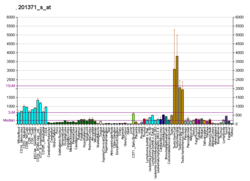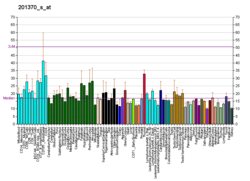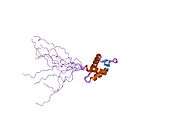CUL3
Cullin-3 is a protein that in humans is encoded by the CUL3 gene.[5][6][7]
Interactions
CUL3 has been shown to interact with:
References
- 1 2 3 GRCh38: Ensembl release 89: ENSG00000036257 - Ensembl, May 2017
- 1 2 3 GRCm38: Ensembl release 89: ENSMUSG00000004364 - Ensembl, May 2017
- ↑ "Human PubMed Reference:".
- ↑ "Mouse PubMed Reference:".
- ↑ Kipreos ET, Lander LE, Wing JP, He WW, Hedgecock EM (Jun 1996). "cul-1 is required for cell cycle exit in C. elegans and identifies a novel gene family". Cell. 85 (6): 829–39. doi:10.1016/S0092-8674(00)81267-2. PMID 8681378.
- ↑ Wimuttisuk W, Singer JD (Mar 2007). "The Cullin3 ubiquitin ligase functions as a Nedd8-bound heterodimer". Molecular Biology of the Cell. 18 (3): 899–909. doi:10.1091/mbc.E06-06-0542. PMC 1805106. PMID 17192413.
- ↑ "Entrez Gene: CUL3 cullin 3".
- ↑ Min KW, Hwang JW, Lee JS, Park Y, Tamura TA, Yoon JB (May 2003). "TIP120A associates with cullins and modulates ubiquitin ligase activity". The Journal of Biological Chemistry. 278 (18): 15905–10. doi:10.1074/jbc.M213070200. PMID 12609982.
- ↑ Singer JD, Gurian-West M, Clurman B, Roberts JM (Sep 1999). "Cullin-3 targets cyclin E for ubiquitination and controls S phase in mammalian cells". Genes & Development. 13 (18): 2375–87. doi:10.1101/gad.13.18.2375. PMC 317026. PMID 10500095.
- ↑ Kim AY, Bommeljé CC, Lee BE, Yonekawa Y, Choi L, Morris LG, Huang G, Kaufman A, Ryan RJ, Hao B, Ramanathan Y, Singh B (Nov 2008). "SCCRO (DCUN1D1) is an essential component of the E3 complex for neddylation". The Journal of Biological Chemistry. 283 (48): 33211–20. doi:10.1074/jbc.M804440200. PMC 2586271. PMID 18826954.
- ↑ Wang XJ, Sun Z, Chen W, Li Y, Villeneuve NF, Zhang DD (Aug 2008). "Activation of Nrf2 by arsenite and monomethylarsonous acid is independent of Keap1-C151: enhanced Keap1-Cul3 interaction". Toxicology and Applied Pharmacology. 230 (3): 383–9. doi:10.1016/j.taap.2008.03.003. PMC 2610481. PMID 18417180.
- ↑ Rachakonda G, Xiong Y, Sekhar KR, Stamer SL, Liebler DC, Freeman ML (Mar 2008). "Covalent modification at Cys151 dissociates the electrophile sensor Keap1 from the ubiquitin ligase CUL3". Chemical Research in Toxicology. 21 (3): 705–10. doi:10.1021/tx700302s. PMID 18251510.
- ↑ Rondou P, Haegeman G, Vanhoenacker P, Van Craenenbroeck K (Apr 2008). "BTB Protein KLHL12 targets the dopamine D4 receptor for ubiquitination by a Cul3-based E3 ligase". The Journal of Biological Chemistry. 283 (17): 11083–96. doi:10.1074/jbc.M708473200. PMC 2431063. PMID 18303015.
External links
- Human CUL3 genome location and CUL3 gene details page in the UCSC Genome Browser.
Further reading
- Andersson B, Wentland MA, Ricafrente JY, Liu W, Gibbs RA (Apr 1996). "A "double adaptor" method for improved shotgun library construction". Analytical Biochemistry. 236 (1): 107–13. doi:10.1006/abio.1996.0138. PMID 8619474.
- Yu W, Andersson B, Worley KC, Muzny DM, Ding Y, Liu W, Ricafrente JY, Wentland MA, Lennon G, Gibbs RA (Apr 1997). "Large-scale concatenation cDNA sequencing". Genome Research. 7 (4): 353–8. doi:10.1101/gr.7.4.353. PMC 139146. PMID 9110174.
- Michel JJ, Xiong Y (Jun 1998). "Human CUL-1, but not other cullin family members, selectively interacts with SKP1 to form a complex with SKP2 and cyclin A". Cell Growth & Differentiation. 9 (6): 435–49. PMID 9663463.
- Du M, Sansores-Garcia L, Zu Z, Wu KK (Sep 1998). "Cloning and expression analysis of a novel salicylate suppressible gene, Hs-CUL-3, a member of cullin/Cdc53 family". The Journal of Biological Chemistry. 273 (38): 24289–92. doi:10.1074/jbc.273.38.24289. PMID 9733711.
- Ishikawa K, Nagase T, Suyama M, Miyajima N, Tanaka A, Kotani H, Nomura N, Ohara O (Jun 1998). "Prediction of the coding sequences of unidentified human genes. X. The complete sequences of 100 new cDNA clones from brain which can code for large proteins in vitro". DNA Research. 5 (3): 169–76. doi:10.1093/dnares/5.3.169. PMID 9734811.
- Ohta T, Michel JJ, Schottelius AJ, Xiong Y (Apr 1999). "ROC1, a homolog of APC11, represents a family of cullin partners with an associated ubiquitin ligase activity". Molecular Cell. 3 (4): 535–41. doi:10.1016/S1097-2765(00)80482-7. PMID 10230407.
- Singer JD, Gurian-West M, Clurman B, Roberts JM (Sep 1999). "Cullin-3 targets cyclin E for ubiquitination and controls S phase in mammalian cells". Genes & Development. 13 (18): 2375–87. doi:10.1101/gad.13.18.2375. PMC 317026. PMID 10500095.
- Hori T, Osaka F, Chiba T, Miyamoto C, Okabayashi K, Shimbara N, Kato S, Tanaka K (Nov 1999). "Covalent modification of all members of human cullin family proteins by NEDD8". Oncogene. 18 (48): 6829–34. doi:10.1038/sj.onc.1203093. PMID 10597293.
- Maeda I, Ohta T, Koizumi H, Fukuda M (Apr 2001). "In vitro ubiquitination of cyclin D1 by ROC1-CUL1 and ROC1-CUL3". FEBS Letters. 494 (3): 181–5. doi:10.1016/S0014-5793(01)02343-2. PMID 11311237.
- Lyapina S, Cope G, Shevchenko A, Serino G, Tsuge T, Zhou C, Wolf DA, Wei N, Shevchenko A, Deshaies RJ (May 2001). "Promotion of NEDD-CUL1 conjugate cleavage by COP9 signalosome". Science. 292 (5520): 1382–5. doi:10.1126/science.1059780. PMID 11337588.
- Min KW, Hwang JW, Lee JS, Park Y, Tamura TA, Yoon JB (May 2003). "TIP120A associates with cullins and modulates ubiquitin ligase activity". The Journal of Biological Chemistry. 278 (18): 15905–10. doi:10.1074/jbc.M213070200. PMID 12609982.
- Kobayashi A, Kang MI, Okawa H, Ohtsuji M, Zenke Y, Chiba T, Igarashi K, Yamamoto M (Aug 2004). "Oxidative stress sensor Keap1 functions as an adaptor for Cul3-based E3 ligase to regulate proteasomal degradation of Nrf2". Molecular and Cellular Biology. 24 (16): 7130–9. doi:10.1128/MCB.24.16.7130-7139.2004. PMC 479737. PMID 15282312.
- Beausoleil SA, Jedrychowski M, Schwartz D, Elias JE, Villén J, Li J, Cohn MA, Cantley LC, Gygi SP (Aug 2004). "Large-scale characterization of HeLa cell nuclear phosphoproteins". Proceedings of the National Academy of Sciences of the United States of America. 101 (33): 12130–5. doi:10.1073/pnas.0404720101. PMC 514446. PMID 15302935.
- Rush J, Moritz A, Lee KA, Guo A, Goss VL, Spek EJ, Zhang H, Zha XM, Polakiewicz RD, Comb MJ (Jan 2005). "Immunoaffinity profiling of tyrosine phosphorylation in cancer cells". Nature Biotechnology. 23 (1): 94–101. doi:10.1038/nbt1046. PMID 15592455.
- Furukawa M, Xiong Y (Jan 2005). "BTB protein Keap1 targets antioxidant transcription factor Nrf2 for ubiquitination by the Cullin 3-Roc1 ligase". Molecular and Cellular Biology. 25 (1): 162–71. doi:10.1128/MCB.25.1.162-171.2005. PMC 538799. PMID 15601839.
- Hernández-Muñoz I, Lund AH, van der Stoop P, Boutsma E, Muijrers I, Verhoeven E, Nusinow DA, Panning B, Marahrens Y, van Lohuizen M (May 2005). "Stable X chromosome inactivation involves the PRC1 Polycomb complex and requires histone MACROH2A1 and the CULLIN3/SPOP ubiquitin E3 ligase". Proceedings of the National Academy of Sciences of the United States of America. 102 (21): 7635–40. doi:10.1073/pnas.0408918102. PMC 1140410. PMID 15897469.
- Lu L, Zhou ZM, Huang XY, Xu M, Yin LL, Wang H, Xu ZY, Sha JH (Jun 2005). "Identification and characterization of cul-3b, a novel hominine CUL-3 transcript variant". Asian Journal of Andrology. 7 (2): 205–11. doi:10.1111/j.1745-7262.2005.00024.x. PMID 15897978.
This article is issued from
Wikipedia.
The text is licensed under Creative Commons - Attribution - Sharealike.
Additional terms may apply for the media files.








